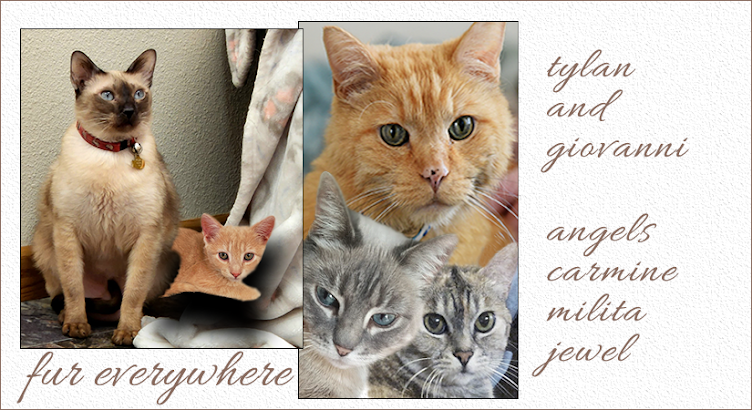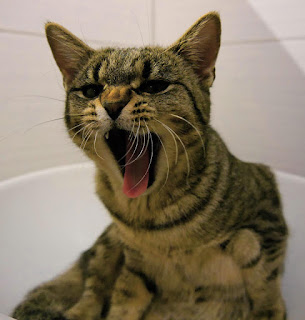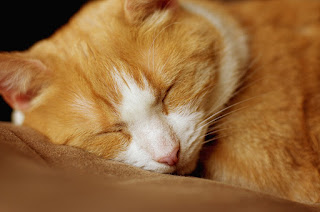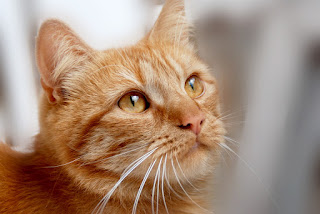Hi everyone! It's mes, Carmine!
Did yous know that September bes Animal Pain Awareness Month? Unfortunately, wes (as animals) cannot tell yous when wes bes in pain, so it be up to yous to observe us and take us to the vet when it looks like wes be in pain. That not always be very easy for the humans to do. Wes kitties hide pain especially well, so it can bes hard for the humans to know when wes are hurting.
Mes is fortunate that my human watches mes very closely and always seems to know when mes isn't feeling my bestest.
Way back when mes was six years old, my human noticed that mes was sleeping more than usual. Hers also noticed mes wasn't jumping up to mines favorite places to bes - up high on hers desk or on the bookcase. The Mom didn't know what was wrong with mes, but hers knew something wasn't quite right. So, hers scooped mes up and took mes to the vet.
The Mom and the vet talked about mes, and theys were a bit stumped. The vet suggested theys get an x-ray of mes, so theys took a photo of my insides. It turns out that mes had arthritis in one of mines hips. The vet told the Mom hers could sprinkle some cosequin on mines food once a day to see if that would help mines pain.
It did, and before you knew it, mes was back to running around and jumping up to my favorite high places like mes used to!
Now mes is going to let the Mom tell yous all about Animal Pain Awareness Month and how to tell if us kitties might bes in pain.
Animal Pain Awareness Month
The International Veterinary Academy of Pain Management (IVAPM) has declared September Animal Pain Awareness Month. This actually coincides with human medicine's Pain Awareness Month. IVAPM strives to raise awareness and educate people about acute and chronic pain and pain management in animals of all species.
Signs Your Cat May Be in Pain
Cats can suffer from acute and chronic pain just like we do. Acute pain is usually easier to spot as it causes distress for your cat. Chronic pain may produce subtler changes in your cat's behavior and personality, making it more difficult to recognize.
Cats in the wild must hide their pain when they are sick or injured in order to protect themselves from predators. Even though cats have been domesticated for thousands of years, cats continue to engage in this protective behavior.
If your cat displays one or more of the following signs, he may be in pain.
Vocalizing: If your cat is in pain, he may talk to you more than usual. He may also hiss or growl at you when you approach or touch him. Purring at times when you don't expect it is another sign your cat may be hurting.
Changes in Activities: If your cat's activity level decreases or changes, chances are that he's in pain. You might notice that your cat is reluctant to jump or doesn't jump as high as he used to, has difficulty getting up from a laying position, repetitively gets up and lays down, limps, protects a certain part of his body, or hides more often than usual. Trembling or shaking, a reluctance to go up or down stairs, pacing or restlessness, less energy, sleeping more than usual, a reluctance to play or chase toys, and avoiding walking on slippery floor surfaces also indicate your cat may be in pain.
Changes in Grooming Habits: Cats are meticulous groomers; a change in grooming habits is a definite sign that something is amiss. A cat in pain may stop grooming part or all of his body. If you notice your cat's coat looking unkept, he is getting mats when he normally doesn't, or his coat looks greasy, your cat may be hurting. On the contrary, sometimes cats in pain increase their grooming, so it's important to pay attention if you see your cat grooming part of his body more than usual. Overgrooming can lead to hair loss or wounds.
Facial Expressions: Cats who are hurting may grimace, have a vacant stare, enlarged pupils, have a wide-eyed stare, look sleepy, flatten their ears, or pant while resting.
Changes in Sleeping Habits: Cats in pain may sleep more or less than usual. You might find your kitty sleeping in strange positions or in places he doesn't normally sleep. Cats in pain may seek out warmer places to sleep, such as near the heating vent or in the sun.
Body Position: A cat's body position can tell you a lot about how they're feeling. A hurting cat may sit with his head lowered and his back arched higher than usual. When a cat in pain lays down, he may keep his legs tucked underneath him instead of laying on his side.
Changes in Eating and Drinking Habits: Pain can cause a cat to be less interested in food and water just like it can for humans. If your cat is hurting, you may notice him eating or drinking less than usual. Remember that changes in eating and drinking habits - eating or drinking more or less than usual - can be a sign of several serious health problems in cats, so it's always important to consult with your veterinarian if you notice changes in your cat's eating and drinking habits.
Uncharacteristic Aggression: A previously gentle cat in pain may begin to act uncharacteristically aggressive. Your cat may hiss or growl when you, other human family members, or other pets in your home approach him. He may hiss, growl, lash out, or bite if you pet him or pick him up. He might try to avoid being picked up and held or pet.
Changes in Litter Box Habits: Cats don't stop using their litter box for no reason. Pain is one of the most common reasons a cat's litter box habits change. If your cat's knees, elbows, spine, or hips are hurting, he may find it too painful to get into and out of the litter box. As a result, your cat may begin to eliminate outside the litter box.
Additionally, cats in pain may have a difficult time squatting in the litter box. As a result, your cat may urinate over the side of the box. He may also become constipated because he holds it when he needs to defecate because having a bowel movement is so uncomfortable.
As a cat parent, you are the best one to look for any signs of pain in your cat. If you notice any of these behavior changes in your cat, it's best to take him to see the veterinarian.
There are many possible causes for acute and chronic pain in cats. Oftentimes, the earlier your vet can determine the source of your cat's discomfort, the more successful pain management is for your cat.






Terrific article. I saw some I didn't know about too.
ReplyDeleteIz haz to go to the V-E-T in Oct. fur my annual checkup (and get out). Soz Lynn triez to keep me healthy.
ReplyDeleteThat was a wonderful post Carmine and Mom, so much to watch and think about, but it's all mighty important! Thanks for hosting this special event.
ReplyDeleteExcellent post. Cats are so good at hiding pain.
ReplyDeleteGreat post, Carmine and Mom Sierra. Cats are so very good at hiding pain, so it's really important to be observant and make sure our kitties get regualr checkups.
ReplyDeleteสล็อต ทางเข้าเล่นที่ดี เว็บออนไลน์ วอเลท เกม pg slot ออนไลน์ยอดฮิตมากที่สุดในขณะนี้ เว็บ pg มาพร้อมเกมส์ออนไลน์ PG SLOT เกมที่มีให้เลือกเล่นมากกว่า 100 เกมให้เลือกเล่น
ReplyDelete